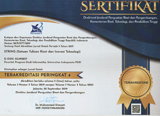Pengaturan Torsi Motor Induksi 3 Phasa Menggunakan Direct Torque Control
(1) Institut Teknologi Adhi Tama Surabaya
(2) Institut Teknologi Adhi Tama Surabaya
(*) Corresponding Author
Abstract
The three-phase induction motor is the most widely used drive in the industry due to its sturdy construction and relatively affordable price. However, there is a disadvantage that it is difficult to control torque and speed dynamically and separately. The torque and speed characteristics of the three-phase induction motor are a couple and are nonlinear. So it is difficult to be able to control torque and speed separately. To overcome these problems, there is a decoupling control method that will separate the control between torque and speed using DTC (Direct Torque Control) by setting the value of the stator flux as a sector selector switching. DCT is a form of vector control. The least square estimation method is used for speed forecasting on induction motors through measurement data of stator flux and rotor flux which are regressed into non-linear form to monitor motor speed. Based on tests using simulations, the results show that when an induction motor is given a torque load, the torque response changes (tracking) the torque response of the induction motor can follow these changes. Where the characteristic value of the response transient, time constant (?) is 0.082 seconds, the rise time (TR) is 0.242 seconds and the settling time (TS) is 0.246 seconds.
Keywords
Full Text:
PDFReferences
Harrij Mukti K, “Implementasi Direct Torque Control Dalam
Pengaturan Kecepatan Motor Induksi,” Jurnal ELTEK, vol. 12, no.
, pp. 64–73, Apr. 2014.
V. K. Alvi, E. Wahjono, O. A. Qudsi, and J. Timur, “Pengaturan
Kecepatan Motor Induksi Tiga Fasa dengan Metode Direct Torque
Control,” vol. 2, no. 3, p. 9, 2020.
Alva Brisbananda Ashari, “Kontrol Kecepatan Motor Induksi
Menggunakan Metode Field Orientation Control (FOC) Berbasis
Fuzzy-PID,” Jurnal Teknik Elektro, vol. 9, no. 3, pp. 763–771,
U. Khasanah, S. Supari, and S. Heranurweni, “SIMULASI
PENGATURAN KECEPATAN MOTOR INDUKSI 3 PHASA DENGAN
DIRECT TORQUE CONTROL MENGGUNAKAN MATLAB,” elektrika,
vol. 9, no. 1, p. 13, Dec. 2018,
doi:10.26623/elektrika.v9i1.1109.
R. Ridwan, E. Purwanto, H. Oktavianto, M. R. Rusli, and H. Toar,
“DESAIN KONTROL KECEPATAN MOTOR INDUKSI TIGA FASA
MENGGUNAKAN FUZZY PID BERBASIS IDIRECT FIELD
ORIENTED CONTROL,” JI, vol. 11, no. 2, pp. 146–155, Oct.
, doi: 10.30871/ji.v11i2.1356.
E. Sunarno, S. Soebagio, and M. H. Purnomo, “Pengaturan
Kecepatan Motor Induksi Tanpa Sensor Kecepatan dengan
Metoda Direct Torque Control Menggunakan Observer Recurrent
Neural Network,” jte, vol. 8, no. 2, pp. 88–95, Apr. 2010, doi:
9744/jte.8.2.88-95.
W. S. Pambudi, E. A. Zuliari, R. A. Firmansyah, Y. A. Prabowo,
and A. Syaifurrizal, “Identification of Flip Folder Model on Folding
Machine,” IOP Conf. Ser.: Mater. Sci. Eng., vol. 462, p. 012009,
Jan. 2019, doi: 10.1088/1757-899X/462/1/012009.
Y. A. Prabowo, R. I. Imaduddin, W. S. Pambudi, R. A.
Firmansyah, and A. Fahruzi, “Identification of automatic guided
vehicle (agv) based on magnetic guided sensor for industrial
material transfer,” IOP Conf. Ser.: Mater. Sci. Eng., vol. 1010, p.
, Jan. 2021, doi: 10.1088/1757-899X/1010/1/012028.
Y. A. Prabowo, W. S. Pambudi, and I. R. Imaduddin,
“Identification of the Flip Folder Folding Machine Using Artificial
Neural Network with Nonlinear Autoregressive Exogenous
Structure,” vol. 5, no. 2, p. 6, 2020.
DOI: http://dx.doi.org/10.30998/string.v7i1.11993
Refbacks
- There are currently no refbacks.
Copyright (c) 2022 Alvin Tri Nugroho

This work is licensed under a Creative Commons Attribution 4.0 International License.
STRING (Satuan Tulisan Riset dan Inovasi Teknologi) indexed by:

Ciptaan disebarluaskan di bawah Lisensi Creative Commons Atribusi 4.0 Internasional.
View My Stats


 Sertifikat Akreditasi
Sertifikat Akreditasi
















